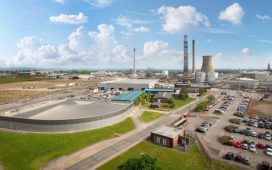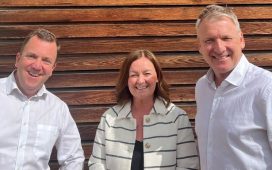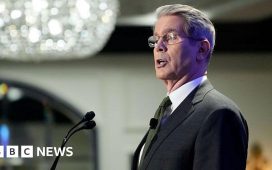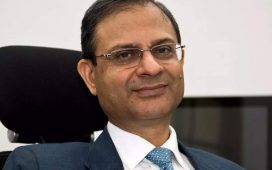European Central Bank lifts interest rates to record high
Newsflash: The European Central Bank has raised interest rates in the eurozone, as it continues its fight against inflation.
The ECB’s Governing Council has decided to raise the three key ECB interest rates by 25 basis points, or a quarter of one percent, after concluding that inflation will be higher than it had expected.
Announcing the move, it says:
Inflation continues to decline but is still expected to remain too high for too long.
This lifts the bank’s benchmark deposit facility rate, which is paid to commercial banks when they deposit money with the central bank overnight, to 4% from 3.75%, a record high.
The EBC’s main refinancing rate, which provide the bulk of liquidity to the banking system, has risen from 4.25% to 4.5%.
The marginal lending facility, charged when banks borrow from the ECB, has risen to 4.75%.
The ECB has also lifted its inflation forecasts for this year, and next year, saying:
The September ECB staff macroeconomic projections for the euro area see average inflation at 5.6% in 2023, 3.2% in 2024 and 2.1% in 2025. This is an upward revision for 2023 and 2024 and a downward revision for 2025. The upward revision for 2023 and 2024 mainly reflects a higher path for energy prices.
Key events
Today’s eurozone interest rate rise is the tenth consecutive time the ECB has tightened monetary policy. points out Victoria Scholar, head of investment at interactive investor.
She adds:
Meanwhile the central bank issued some gloomy forecasts on the economy, cutting its 2023-24 growth outlook and raising its inflation guidance for next year, suggesting price pressures will take longer to shake off than previously anticipated. Inflation is expected to be at 5.6% in 2023, 3.2% in 2024 and finally around target at 2.1% by 2025.
The ECB began tightening later than the Fed and the Bank of England, landing it behind the curve, which forced the central bank into acting more swiftly. But that aggressive policy has had consequences for the euro zone economy with Germany potentially heading into a recession. With sluggish growth and increased labour market slack, the more dovish ECB rate setters believed a pause would have been more appropriate, but the governing council decided to prioritise tackling inflation, even if it comes at a cost to the economy. Looking ahead, the recent rally in oil prices is likely to muddy the picture for the ECB by standing in the way of the eurozone’s disinflationary path.
Government bond yields in the euro zone fell despite another hike from the ECB. Price action in the bond market reflects the ECB’s signalling that it is probably at the end of this tightening cycle, even though inflation for August hit 5.3%, still sharply above its 2% target.
ECB President Lagarde said she expect inflation to fall in the coming months. And no doubt the governing council is also worried about a significant slowdown in the euro zone economy, given the weakness in recent indicators.”
“We are not saying that we are now at peak [interest rates],” Christine Lagarde adds.
Q: Is today’s interest rate increase a ‘dovish hike’ – is this the end of the rate hiking cycle, or do you leave the door open?
Christine Lagarde points to the line in today’s statement, that the ECB will take a data-dependant approach about how high interest rates should rise, and how long they should remain there.
Q: Did you discuss how long rates would have to stay at their peak level?
Lagarde says the ECB did not discuss how long would be long enough – because policymakers will remain ‘data dependent’.
Lagarde: Some policymakers would have preferred to pause today
Christine Lagarde, ECB president, is taking questions now, and reveals that today’s decision to raise interest rates was not unanimous.
Q: How did the discussion go, between the hawks and doves on the ECB’s governing council?
Lagarde says policymakers had “a lot of data”, and a lot of analysis from ECB staff, which was looked at “very closely”, at presentations lasting many hours.
But, she says, “some members did not draw the same conclusion”.
Some governors would have preferred to pause, to wait until they had “more certainty, more intelligence”, and seen the impact of previous interest rate hikes.
[that’s because monetary. policy acts with a lag – it takes time for higher interest rates to influence the real economy].
Lagarde says:
There was a solid majority of the governors to agree with the decision that we have made….
There are a few members in the governing council who would have preferred another one [another decision].
She insists it was not an adversarial discussion.
Here are the ECB’s new, downgraded, growth forecasts….
…. and its new, higher inflation forecasts:
ECB president Christine Lagarde is holding a press conference now, to explain today’s interest rate decision.
Lagarde tells reporters that the eurozone economy is likely to remain subdued in the coming months.
It broadly stagnated over the first half of the year, and recent indicators suggest it has also been weak in the third quarter.
Growth is being dampened by lower demand for eurozone exports and the impact of tight financing conditions, says Lagarde, adding that the services sector is now weakening.
But, she says economic momentum should pick up as real incomes rise (ie, wages rising faster than inflation).
After a brief jump, the euro has now fallen by half a cent against the US dollar to $1.0674.
Interest rate rises should, classically, boost a currency. But today, traders are noting the ECB’s point that interest rates are now high enough to make a ‘substantial contribution’ to bringing inflation down to its 2% target.
More economists are predicting that today’s ECB interest rate hike will be the last in this cycle.
Mike Bell, global liquidity market strategist at J.P. Morgan Asset Management, explains:
“With the business surveys indicating an imminent sharp slowdown in growth, the ECB are probably done hiking.
“The new orders component of the latest business surveys were very weak. Incoming new business for the service sector is contracting now, joining new orders for the manufacturing sector in the doldrums.
But while the ECB could hit the pause button now, eurozone households and companies may face a wait until rates fall.
Bell says:
“Against the weaker growth backdrop, the ECB can probably pause at the next meeting and if the growth outlook continues to deteriorate a pause could morph into a peak.
“However, unless unemployment rises sharply and rapidly, the outlook for Eurozone interest rates could end up looking like table mountain with rates on hold for quite some time.”
The fear of not getting inflation fully under control and the risk of stopping too early must have over-riden the rising recession risk in the eurozone and prompted today’s ECB interest rate rise, says Carsten Brzeski, ING’s global head of macro.
Brzeski adds:
The ECB only has one job and this job is to maintain price stability. The eurozone has not seen price stability in almost three years. And even if the inflation surge is mainly due to factors outside of the ECB’s direct reach, the Bank simply has to show its determination to stamp it out. That this approach will eventually push the eurozone economy into a more severe slowdown does not matter to the ECB, at least not for now.
Looking ahead, a further weakening of the economy and more traction in a disinflationary trend will make it very hard to find arguments for yet another rate hike before the end of the year. The remark in the official communication that “based on its current assessment, the Governing Council considers that the key ECB interest rates have reached levels that, maintained for a sufficiently long duration, will make a substantial contribution to the timely return of inflation to the target” shows that today’s rate hike looks like the last.
Today’s hike isn’t only a credibility booster, it will also be the last in the current cycle.
Today’s ECB announcement also contains a hint that eurozone interest rates are now at or at least near their peak.
The ECB says:
Based on its current assessment, the Governing Council considers that the key ECB interest rates have reached levels that, maintained for a sufficiently long duration, will make a substantial contribution to the timely return of inflation to the target.
The Governing Council’s future decisions will ensure that the key ECB interest rates will be set at sufficiently restrictive levels for as long as necessary.
The ECB adds that its Governing Council will continue to follow “a data-dependent approach” to determining the appropriate level of interest rates, and how long they stay in restrictive levels.
European Central Bank policymakers have also cut their forecast for growth in the eurozone, due to the impact of higher interest rates.
They say:
The Governing Council’s past interest rate increases continue to be transmitted forcefully.
Financing conditions have tightened further and are increasingly dampening demand, which is an important factor in bringing inflation back to target.
With the increasing impact of this tightening on domestic demand and the weakening international trade environment, ECB staff have lowered their economic growth projections significantly.
The ECB now expect the euro area economy to expand by just 0.7% in 2023, down from the 0.9% growth forecast in June.
Expected growth in 2024 has been downgraded to 1.0% from 1.5% three months ago, while 2025’s forecast has been trimmed to 1.5% growth from 1.6%.
🇪🇺 New ECB staff projections:
– GDP growth lower throughout 2025
– headline inflation up by 20bp in 2023-24
– 2025 headline and core inflation down by 10bp, still above target
At peak rates the focus will be on policy transmission, and how long rates need to stay at this level. pic.twitter.com/x8NTenpbPD— Frederik Ducrozet (@fwred) September 14, 2023









